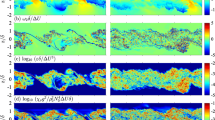Abstract
The dependence of results from coarse-resolution models of the North Atlantic circulation on the numerical advection algorithm is studied. In particular, the sensitivity of parameters relevant for climate simulations as e.g., meridional transport of mass and heat and main thermocline thickness is investigated. Three algorithms were considered: (a) a central difference scheme with constant values for horizontal and vertical diffusion, (b) an upstream scheme with no explicit diffusion, and (c) a flux-corrected transport (FCT) scheme with constant and strictly isopycnal diffusion. The temporal evolution of the three models on time scales of centuries is markedly different, the upstream scheme resulting in much shorter adjustment time whereas the central difference scheme is slower and controlled by vertical diffusion rather than advection. In the steady state, the main thermocline structure is much less diffusive in the FCT calculation which also has much lower heat transport. Both horizontal circulation and overturning in the meridional-vertical plane are strongest in the upstream-model. The results are discussed in terms of the effective vertical (diapycnal) mixing in the different models. A significant increase in vertical resolution would be required to eliminate the high sensitivity due to the numerical algorithms, and allow physically motivated mixing formulations to become effective.
Similar content being viewed by others
References
Boris JP, Book DL (1973) Flux-corrected transport, I. SHASTA: A fluid transport algorithm that works. J Comput Phys 11:38–69
Bryan F (1987) Parameter sensitivity of primitive equation ocean general circulation models. J Phys Oceanogr 17:970–985
Bryan K (1962) Measurements of meridional heat transport by ocean currents. J Geophys Res 67:3403–3414
Bryan K, Manabe S, Pacanowski RC (1975) A global ocean-atmosphere climate model. Part II. The oceanic circulation. J Phys Oceanogr 5:30–46
Bryan K, Lewis LJ (1979) A water mass model of the world ocean. J Geophys Res 84:2503–2517
Bryan K, Spelman MJ (1985) The ocean's response to a CO2-induced warming. J Geophys Res 90, C6:11679–11688
Colin de Verdiere A (1988) Buoyancy driven planetary flows. J Mar Res 46 (2):215–265
Cox MD (1984) A primitive equation, 3-dimensional model of the ocean. GFDL Ocean Group Tech Rep No. 1, GFDL/Princeton University USA
Cox MD (1985) An eddy resolving numerical model of the ventilated thermocline. J Phys Oceanogr 15:1312–1324
Cox MD (1987) An isopycnal diffusion in a z-coordinate ocean model. Ocean modelling 74:1–5 (Unpublished manuscript)
Fiadeiro ME, Veronis G (1977) On weighted-mean schemes for the finite-difference approximation to the advection-diffusion equation. Tellus 29:512–522
Gargett AE (1984) Vertical eddy diffusivity in the ocean interior. J Mar Res 42:359–393
Gent PR, McWilliams JC (1990) Isopycnal mixing in ocean circulation models. J Phys Oceanogr 20:150–155
Gerdes R (1988) Die Rolle der Dichtediffusion in numerischen Modellen der Nordatlantischen Zirkulation (in German). Ber Inst Meeresk Kiel, FRG 179:pp 176
Gordon AL (1986) Interocean exchange of thermocline water. J Geophys Res 91:5037–5046
Gregg MC (1987) Diapycnal mixing in the thermocline: a review. J Geophys Res 92:5249–5286
Hasselmann K (1982) An ocean circulation model for climate variability studies. Prog Oceanogr 11:69–92
Hellermann S, Rosenstein M (1983) Normal monthly wind stress over the world ocean with error estimates. J Phys Oceanogr 13:1093–1104
Holloway G (1989) Subgridscale representation. In: Anderson DLT, Willebrand J (eds) Modelling the ocean general circulation and geochemical tracer transport. Reidel, Dordrecht
Isemer H-J, Hasse L (1987) The Bunker climate atlas of the North Atlantic Ocean. Vol 2, Air sea interaction. Springer, Berlin Heidelberg New York
Levitus S (1982) Climatological atlas of the world Ocean. NOAA Technical Paper 3
Luyten JR, Pedlosky J, Stommel H (1983) The ventilated thermocline. J Phys Oceanogr 13:292–309
Marotzke J, Willebrand J (1991) Multiple equilibria of the global thermohaline circulation. J Phys Oceanogr (in press)
Maier-Reimer E, Mikolajewicz U (1989) Experiments with an OGCM on the cause of the Younger Dryas. In: Ayala-Castanares, Wooster W, Yanez-Arancibia A (eds) Oceanography 1988. UNAM Press, Mexico DF, pp 87–100
Mesinger F, Arakawa A (1976) Numerical methods used in atmospheric models. GARP Publications Series No. 17, vol 1
Musgrave DL (1985) A numerical study of the roles of subgyrescale mixing and the western boundary current on homogenization of a passive tracer. J Geophys Res 90:7037–7043
O'Brien JJ (ed) (1986) Advanced physical oceanographic numerical modeling. Reidel, Hingham, Mass, USA
Olbers DJ, Wenzel M, Willebrand J (1985) The inference of North Atlantic circulation patterns from climatological hydrographic data. Rev Geophys 23:313–356
Pacanowski RC, Philander SGH (1981) Parameterization of vertical mixing in numerical models. J Phys Oceanogr 11:1443–1451
Redi MH (1982) Oceanic isopycnal mixing by coordinate rotation. J Phys Oceanogr 12:1154–1158
Rhines PB, Young WR (1982) Homogenization of potential vorticity in planetary gyres. J Fluid Mech 122:347–367
Roemmich D, Wunsch C (1985) Two transatlantic sections: Meridional circulation and heat flux in the subtropical North Atlantic. Deep-Sea Res 32:619–644
Rood RB (1987) Numerical advection algorithms and their role in atmospheric transport and chemistry models. Rev Geophys 25:71–100
Sarmiento JL (1986) On the north and tropical Atlantic heat balance. J Geophys Res 91:11677–11689
Sarmiento JL, Bryan K (1982) An ocean transport model for the North North Atlantic. J Geophys Res 87:394–408
Semtner AJ, Chervin RM (1988) A simulation of the global ocean circulation with resolved eddies. J Geophys Res 93: No. C12, 15502–15522
Stommel H (1948) The westward intensification of wind-driven ocean currents, Trans. Am Geophys Union 29:202–206
Weaver AJ, Sarachik ES (1990) On the importance of vertical resolution in certain ocean climate models. J Phys Oceanogr 20:600–609
Zalesak ST (1979) Fully multidimensional flux-corrected transport algorithms for fluid. J Comput Phys 31:335–362
Author information
Authors and Affiliations
Additional information
This paper was presented at the International Conference on Modelling of Global Climate Change and Variability, held in Hamburg 11–15 September 1989 under the auspices of the Meteorological Institute of the University of Hamburg and the Max Planck Institute for Meteorology. Guest Editor for these papers is Dr. L. Dümenil
Rights and permissions
About this article
Cite this article
Gerdes, R., Köberle, C. & Willebrand, J. The influence of numerical advection schemes on the results of ocean general circulation models. Climate Dynamics 5, 211–226 (1991). https://doi.org/10.1007/BF00210006
Received:
Accepted:
Issue Date:
DOI: https://doi.org/10.1007/BF00210006




